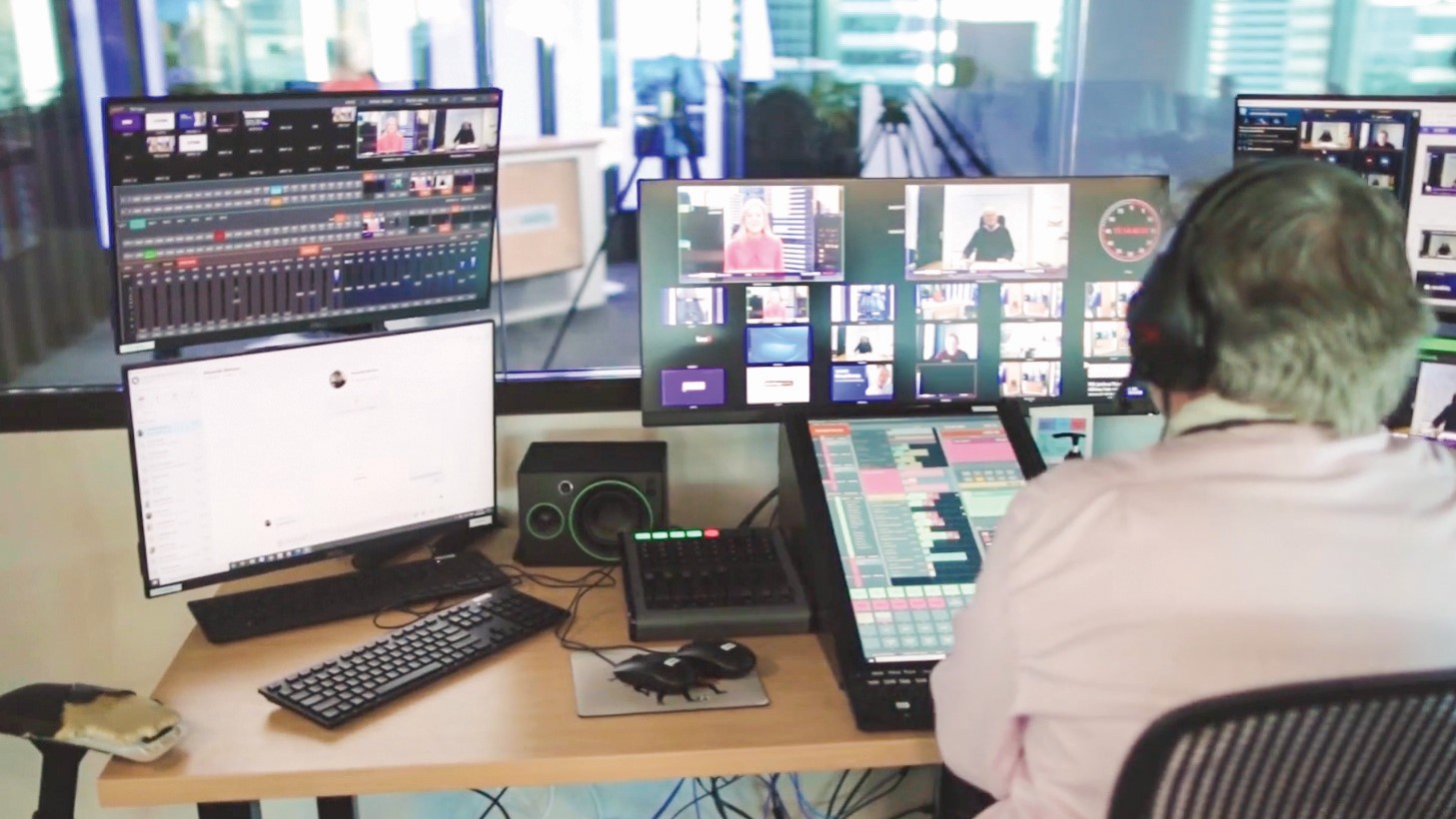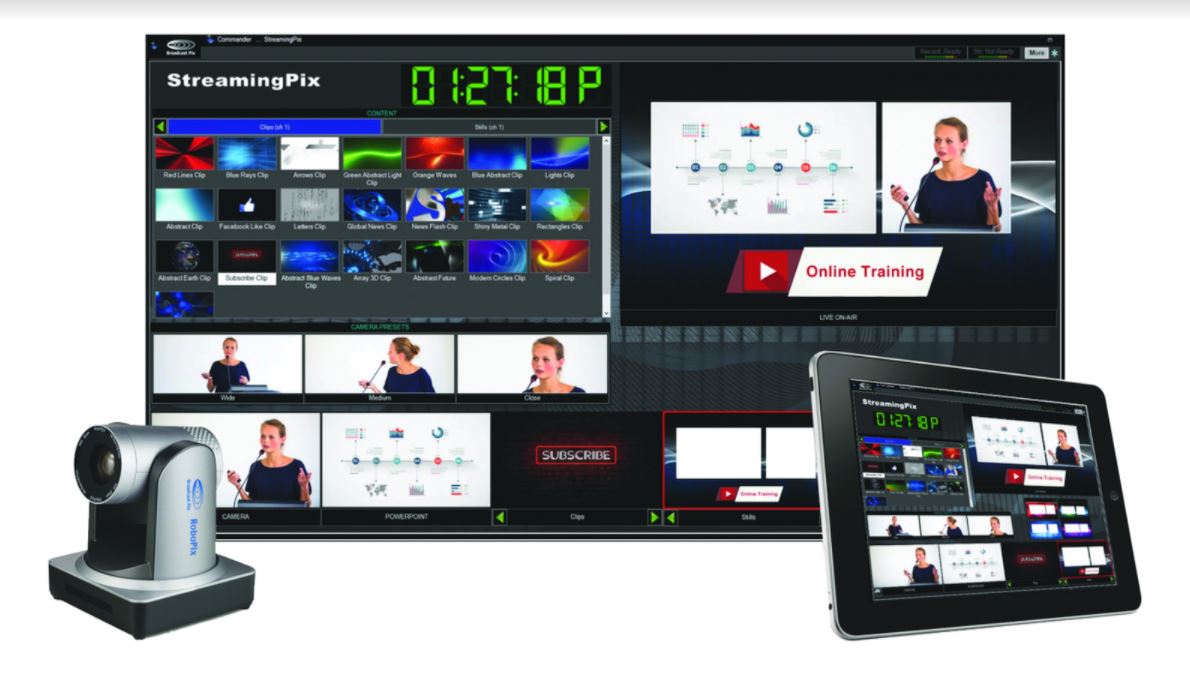Integrated Production Tools Shine During Pandemic
All-in-one systems more comfortable at home

SAN FRANCISCO—Over the past 12 months, as the coronavirus pandemic fulminated around the world, production teams faced shuttered newsrooms, new safety protocols, news team layoffs and shelter-at-home orders.
Then, ironically, demand for content skyrocketed as people began to shelter at home. And it quickly became clear that the day-today business of content production had to be rethought. For many media companies, steps like editing, graphics and proxy storage needed to move from on-premise locations and be accessible remotely to myriad staffers in their own homes.
The pandemic forced the content creation industry to figure out how it could respond to that demand, immediately.

“The pandemic has transformed things a great deal,” said Damon Hawkins, product manager at Grass Valley. “Customers now want to do a lot more remote working,” he said, as the pandemic forced both technology companies and content creators to fast-track use of remote tools.
IMMEDIATE SOLUTIONS
It’s a trend that has long been on the horizon.
“The movement towards partial or complete remote production was well underway before the current global health crisis,” said Matt Allard, senior product marketing manager at Vizrt. “The impact of this emergency has been to significantly hasten the planning and implementation of some types of remote scenarios.” That includes organizations suddenly in lockdown that now needed an immediate solution as well as those that used the pause to rethink how they could deploy production resources.
A driving factor in any solution is that there must be an increased level of integrated functionality, according to Allard. “Integrated systems enable a single operator to perform a variety of tasks, or multiple contributors to collaborate across the network remotely.”
The professional video industry's #1 source for news, trends and product and tech information. Sign up below.
The upside of increased remote use of integrated systems means new opportunities for creativity and collaboration, without being limited to where staff and equipment resources are located. This has proven true for sports, broadcast news or houses of worship.
“Sporting events may not have fans in the stadiums, but production crews developed ways to remotely broadcast and stream out games,” Allard said. “Broadcasters found new ways to remotely present information with technologies such as virtual sets and augmented reality graphics. When people were not able to attend classes or religious services in person, educational and religious organizations brought in integrated production solutions to produce and send out content to homes.”
NETWORK DEMAND
Among all else, the year 2020 required the industry to think fast and adapt quickly.
“On one hand the pandemic clearly accelerated our users’ desire to move to remote productions, so we spent a lot of time supporting our existing users through the transition,” said Graham Sharp, CEO of Broadcast Pix in Boston. Disparate entities like Saint Luke’s Cathedral in Portland, Maine, livestreamed their worship services with Broadcast Pix equipment while educational broadcasters like GovTV in San Diego utilized the company’s integrated remote production control and streaming to produce coverage of live events remotely.
The Broadcast Pix product line features an abstracted architecture such that the control surface and the inputs can be remote from the processing engine and connected by the public internet, Sharp said.
“Most of the support we provided was not really on our product, but helping our users set up and connect their networks,” he said. “If there is one thing that this showed, it is that our industry has some work to do to become proficient in networks and network management.”
COMBINING LIVE AND AUTOMATION
Remote working has proven valuable to international outlets as well. The financial news channel ausbiz in Sydney, Australia, built an editorial news service where journalists could download and edit video content without needing a large, on-premise installation requiring expensive studio crews.
The goal for ausbiz was to build a channel that caters to super niche audiences through a software-driven solution. Those pieces included Vizrt’s Viz Verdi, part of an automated digital media production system that combines live switching with studio automation, as well as the Viz Pilot newsroom graphics system and Viz Engine compositing and graphics solution.
“Even during a lockdown, [the system was used to] combine live production with automation where a single journalist can produce an entire segment from start to finish,” Allard said.
Software running on common off-the-shelf computer hardware is continuing to upend legacy production systems running on dedicated hardware, said Allard, “that offers content production creators a more agile approach providing faster adoption of new capabilities and stands future-ready as requirements change.”
Just as most major business software solutions have become virtualized to run in cloud environments, production software is also trending in the same way. “Besides more flexible access, users benefit from SaaS plans by better matching their needs and implementing a solution for limited time periods, and getting started with low upfront costs,” he said.
This shift is indicative of where the industry is headed. Customers are looking for remote workflows, Hawkins said, and moving forward, he thinks more of them will be embracing the cloud. “Our actual working environment is being driven toward HTML 5 and web-based tool sets,” he said. “Even if workers are coming into the office, they want to work differently.”
The use of remote technologies has impacted more than just large media companies.
Rush Beesley, founder of RUSHWORKS in Dallas, said the company was quick to respond to the increased demand for its VDESK integrated production system from municipalities, houses of worship and entertainment production venues. The key, according to Beesley, has been a mix of robotic camera control coupled with remote production capability using the company’s LogMeIn remote access software, which enabled adaptation for different types of media.
The demand for one-touch-type of productions led the company to upgrade its VDESK software to “make it even more powerful through the implementation of one-touch motion presets that greatly enhance remote production value,” Beesley said.
As content creators continue to look for streamlined productions, media tech vendors expect to see demand for systems that allow productions to be manned by a skeleton crew if needed.
“We project ... an even broader expansion of remote control capabilities, tightly integrated into ‘hybrid’ production scenarios which feature a mix of on-site attendees and remote participants,” Beesley said. “It’s the natural evolution of technology for a global society coping with requirements to remain physically distanced while accomplishing day-to-day job requirements.”
MAKE IT SIMPLE
When the pandemic began in early 2020, companies took extraordinary steps to get customers up and running remotely. Grass Valley, for example, provided free trial licenses of Edius, its video editing software, in the early days of the pandemic. Others, like Broadcast Pix, rolled out dedicated streaming solutions like StreamingPix.

“My key takeaway from the year was that our focus on ease of use was correct, but we did not go far enough,” Sharp said. “With everyone working from home and the market for streaming and remote production exploding, I think it showed the industry how complex most solutions are to install and use.”
When developing StreamingPix, the company had ease-of-installation and ease-of-use in mind. “We packaged everything required in the box, including market-specific templates and even content to get our users up and running quickly,” Sharp added.
Yet even as many media companies embrace remote operations, there will be others who are not ready to jump into the cloud full-time.
“Not everyone wants to use the cloud and not everyone has the pockets deep enough for a mega infrastructure [shift],” Hawkins said. The future will undoubtedly be a mixture of both, he said. “The drive is toward the cloud but there is always the need for on-premise hardware.”
What we can all agree upon is that a shift is certainly afoot.
“We know that the audience has moved from traditional media to now include the internet and other forms of digital distribution,” said Dr. Andrew Cross, president of R&D for the Vizrt Group when he announced the introduction of the company’s new Flexible Access technology philosophy.
“This [shift] represents the single greatest challenge that broadcast TV has ever faced in the last 50 years,” he said. “Business models have changed. People are viewing TV that is now being distributed on social media channels and online content portals, and this is a trend that will increasingly grow.
“The world of broadcasting has changed so we can’t sit here and assume things are working the same way.”
Susan Ashworth is the former editor of TV Technology. In addition to her work covering the broadcast television industry, she has served as editor of two housing finance magazines and written about topics as varied as education, radio, chess, music and sports. Outside of her life as a writer, she recently served as president of a local nonprofit organization supporting girls in baseball.

